The purpose of this cultivator evaluation was to look at disc machines that could cultivate shallow and deep to provide versatility as a tool on a tillage farm.
Shallow cultivation stimulates weed seed germination as well as killing existing vegetation. But the cutting of the soil must be complete with an ability to penetrate in dry conditions. Having a shallow cultivation helps prevent the risks associated with getting rain on a depth of loose soil.
With a disc machine on stubble, the objective would be to work as shallow as is practically possible in the 2-3in band. The objective is to get a complete cut of existing vegetation without having to go too deep and to limit the amount of loose soil to the depth of the lugs on a tyre. So that was the first challenge.
Seedbed
The second challenge was to be able to cultivate much deeper to prepare a seedbed ahead of a min-till drill. In the tests, we asked the operators to do a shallow run, as above, and a deep run, and also a shallow run followed by a deep run so it was cultivated twice.
With disc machines, one of the requirements is for speed to help mix soil and stubble and to shake the soil from the root balls. But it is also good to have the stubble lying on top as this provides cover for beetles and other soil life that are beneficial to the grower. For the deep run and the second pass, the objective is to generate a suitable seed bed and have the minimum of stubble or straw on top of the ground, so a clean finish is required. Residual herbicides cannot work when sprayed on to a cover of vegetation.
The machines were tested in barley stubble where there was an amount of vegetation regrowth behind the combine. This provided an additional challenge. The soil itself was marginally damp for cultivation when the machines were running, which also increased the challenge.
The comments in this article relate to the job of work that the machines did. No machine was a bad machine and altered settings and speed could produce a very different result.
A total of 11 machines arrived to Wexford for the field evaluation. All of the main manufacturers provided us with a 3-metre disc option from their ranges. Interestingly, a couple of lesser-known machines also participated. From a machine point of view, we looked at the specification, adjustments and setup, along with operation in the field.
We also used a Fendt 516 Profi tractor delivering 165hp to pull each machine. For this part of the evaluation we set the machine to work at 3in and observed the fuel monitor on the Fendt over the two runs carried out. A forward speed of 12 km/h was agreed for the test. This report will summarise the key finding from each machine. This week we will look at the first five machines and next week the remainder on test will be reported on.
Our tillage editor Andy Doyle was charged with the task of examining the work that these harrows carried out in the soil. Andy examined the machines at two working depths, to evaluate how effective each machine was at shallow and deep cultivation. Finally the last assessment by Andy examined the ability of each machine to generate a seedbed.
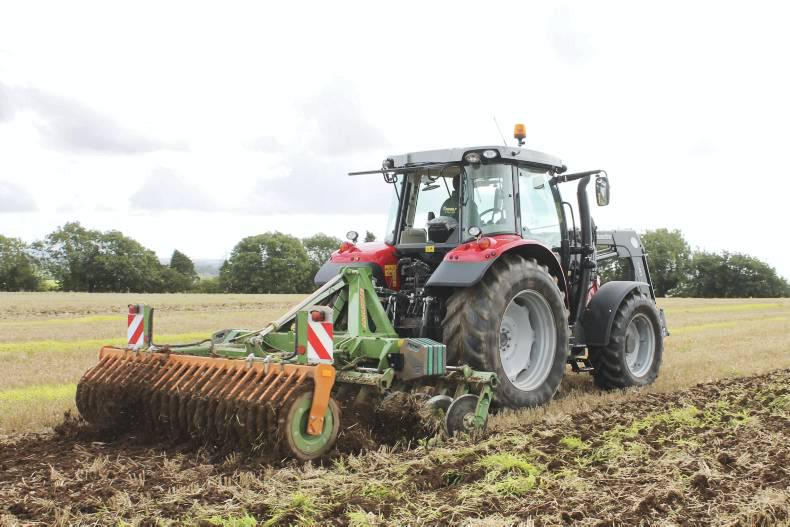
Amazone Catros 3001
This German-built machine has two rows of 12 discs. Each disc is mounted on its own suspension arm and connected to the arm by a “sealed-for-life” oil filled bearing hub.
The test machine featured smooth, 460mm diameter discs which importers Farmhand explained work better for shallow cultivating. It is available with larger scalloped discs if required.
There are five rear roller options available from Amazone. Farmhand mainly offers three versions – a wedge-ring (fitted to test machine), crumbler roller and packer roller. Double crumbler roller and knife ring roller are also available.
Working depth is adjusted manually via a top link between the machine and wedge-ring roller. Hydraulic depth control is also available.
Unique to the Catros 3001 is the ability to offset the front and rear rows of discs up to 3.5 metres wide. According to Farmhand this allows the machine to be configured for different soils conditions, working depths and disc wear.
Adjustments are made manually by changing the disc stop position and driving forward/reversing with the discs in the ground until they reach the new stop point/width setting.
Farmhand has developed a unique set of weight options for the Catros. Customers can specify weight frames fitted to the Catros that suit their own farm tractor weights. This potentially saves having to purchase expensive extra weights for tough ground conditions. For example, the test machine was fitted with Massey Ferguson weights.
We found that this machine left a very even surface finish. Depth adjustment is made by a manual ratchet system to alter the rear packer roller. There was no indication of the working depth on the machine from the cab; the operator can check the depth in the field, which is advisable. From a fuel point of view, the tractor’s display indicated that 21 litres/hr of fuel were being burned while working the machine. The power and weight requirement was easily catered for by the test tractor.
Andy’s view in the field
Shallow: Did a very nice and even job where it was stubbles alone at about 2-3in but coped less well where there was greenery.
Deep: No difficulty getting the depth but the greenery tended to be left in lumps or tufts which could regrow. Thrash burial was much better and the finish was quite firm.
Double pass: Overall job was much better, with better trash burial. This plot was quite level.
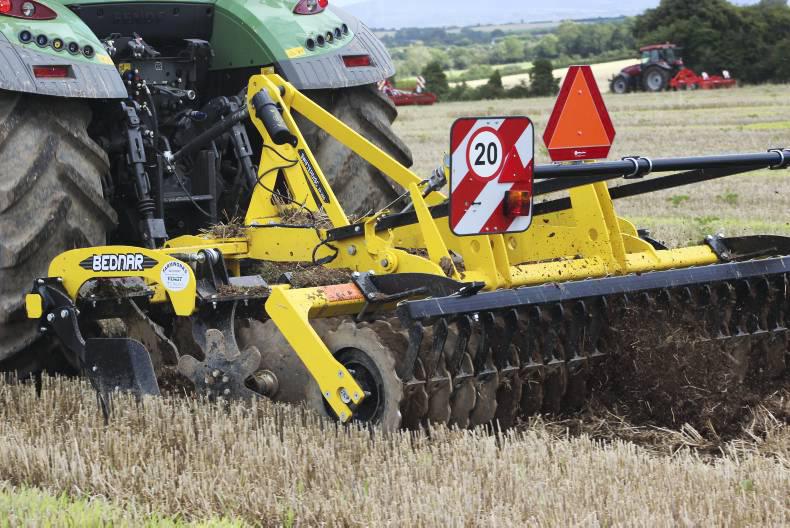
Bednar XN 3000
This harrow features 20 scalloped discs over the 3-metre working width. The aggressive disc design gives a better cultivation of the stubble, according to Bednar.
The height is adjusted mechanically via the top link system where adjustment spacers can be added or taken out to give the desired depth.
Hydraulic depth control is also available. On the machine there is a visual indication of the selected height. This machine weighs in at 1,650 kg, which is somewhere in the middle for this specification. Our impression when driving the machine was that there was very little adjustment that we could carry out, except for height. A small toplink on the side of the machine adjusted the outer disc to prevent ridging between passes.
In some of the high stubble and green ground it did block a small amount. This could be due to the disc not having enough work done to shine up. Again, this disc did not give any trouble to the Fendt tractor in the field. The tractor burned 21.8 litres/hr in operation.
The maximum speed for operation according to Bednar is 15km/hr. We tested the machine at 12 km/hr as we did all machines. For further information, contact sales manager Andrew Wheelock on 087 2864251.
Andy’s view in the field
Shallow: Attempted to work at 2-3in but not all the vegetation was undercut. Some of the stubble and greenery still had a solid grip in the soil. This machine could work deeper if set to do so. Some of the stubble greenery was just flipped over.
Deep: Did not hit the depth target for a one-pass or min-till drill unit. Lack of depth also meant that there was a lot of dirt on top, which could cause problems with existing greenery. Finish was not level.
Double pass: Gave a better and cleaner finish but it did not meet the five-inch target.
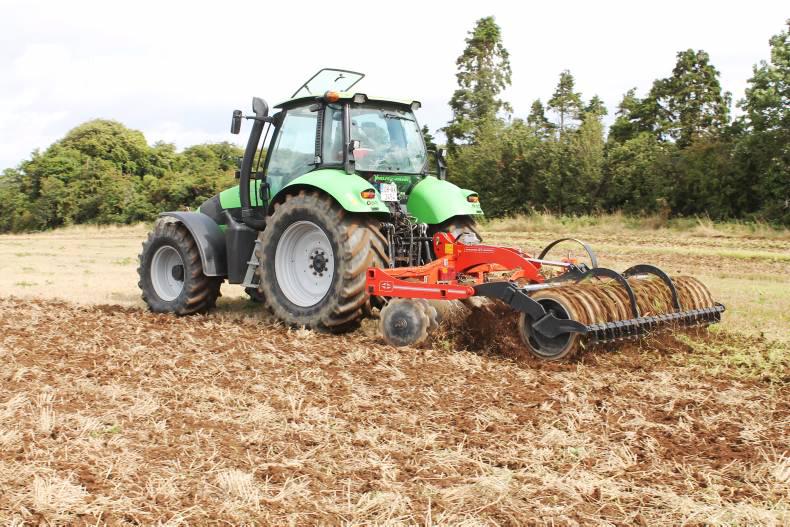
Besson Discomix 3000
Made by French firm Gregoire Besson and handled in Ireland by Kilkenny-based IAM, the Discomix 3000 features two rows of 12 discs.
There are a number of disc options, but IAM has opted for 630mm scalloped discs with a flat profile which are a substantial 7mm thick. Discs are mounted in pairs on a single arm connected to a rubber buffer suspension unit on the main frame.
The duo-disc design reduces the potential risk of blockages, according to IAM. It gives two reasons for this – a single leg design per two discs provides more clearance for material to pass through, and the pair of discs is connected and run/drive together.
The discs are not maintenance free; instead, the bearing hub is greasable. The bearings inside the hub are protected from over-greasing by a relief valve on the hub, and are protected from contamination by a dust and a grease seal.
At the rear of the demo Gregoire Besson Discomix 3000 is the firm’s Emopak F. Other options include crumbler, diamond and Emopak flat or v rollers.
Depth control is via a hydraulic ram between the main frame and packer roller. A large indicator and pointer provide a visual on the machine’s working depth. Hydraulic depth control of the roller allows weight transfer on to the disc cultivator if required. It also facilitates complete folding up of the roller over the machine to transfer the weight closer to the tractor for transport.
From driving this machine on the test, these are two impressive features. The simplicity of altering the depth is convenient. Also, the depth gauge is very clear to read from the tractor cab.
Working in the soil at 3in, the tractor fuel rate averaged at 21.6 litres/hr. The machine was the heaviest of those on test at 2,400kg.
From an operation point of view, it is very easy to set and mount to the tractor.
The folding packer roller is advantageous for tight entrances and weight distribution on the tractor for the road.
Andy’s view in the field
Shallow: This machine cut at 3-4in. Some discs appeared to show sideways movement rather than inversion. There was good mixing of trash but the surface was not very level.
Deep: No difficulty getting down to the required depth. Finish was loose but solid to walk on. Not really any cleaner than the shallow cut.
Double pass: This was a better job. Coped well with the regrowth and left very little stubble showing. Good mixing was evident.
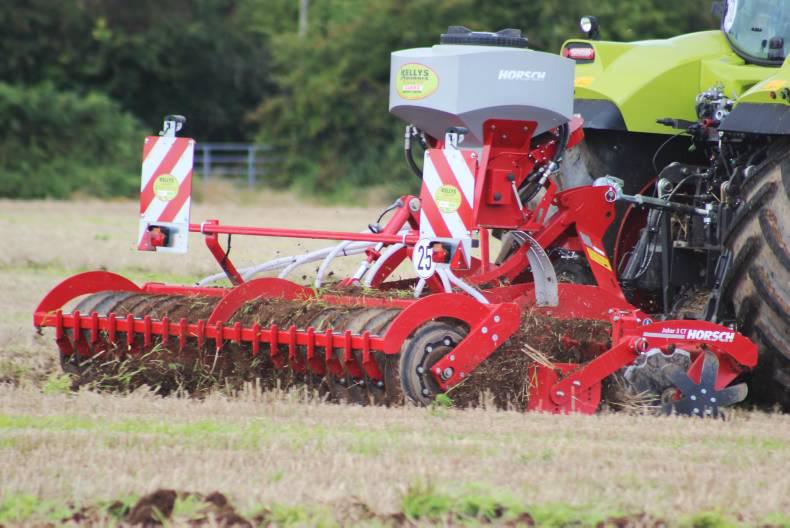
Horsch Joker 3CT
Kelly’s of Borris brought a Horsch Joker 3CT to the test. It arrived with a couple of options. These included a Horsch TG-bar which features five deep cultivation legs and a seeded unit. The TG bar was uncoupled for the test. The Joker 3CT disc cultivator again uses two rows of discs with 12 discs on each row. There are two 520mm-diameter discs mounted on each arm to give maximum clearance when handling trash according to Johnny Leech.
He adds that the 400mm wide mounting bracket/suspension unit makes the discs very stable, with little or no left to right movement. Disc hubs are maintenance free and large-diameter bearings are used which run in oil.
A closed steel disc packer roller was fitted to the demo machine. Again there are many other options, including FarmFlex, RollFlex and crumbler rollers.
The demo Joker 3CT was fitted with the optional hydraulic depth control and depth control suspension, which Johnny says helps cancel out disc bounce. It can also be used to transfer weight on to the discs if necessary. Driving the Horsch machine was no challenge to the Fendt 516, burning just 18 litres/hr. The optional hydraulic depth control was very easy to use, and the depth gauge was plainly visible from the cab. A general observation of soil on the frame of the machine indicates the machine is effectively working.
Andy’s view in the field
Shallow: This machine had the shallowest of all cuts but it shook out all of the stubble and greenery, which made this plot look nice and tidy.
Deep: Had no difficulty getting down to 4-5in but there was more bunching in the areas of regrowth. This plot was cleaner looking than most others and the overall job was quite level. The finish was a bit soft.
Double pass: A good job with even better trash incorporation, very little stubble showing and the finish was reasonably firm.
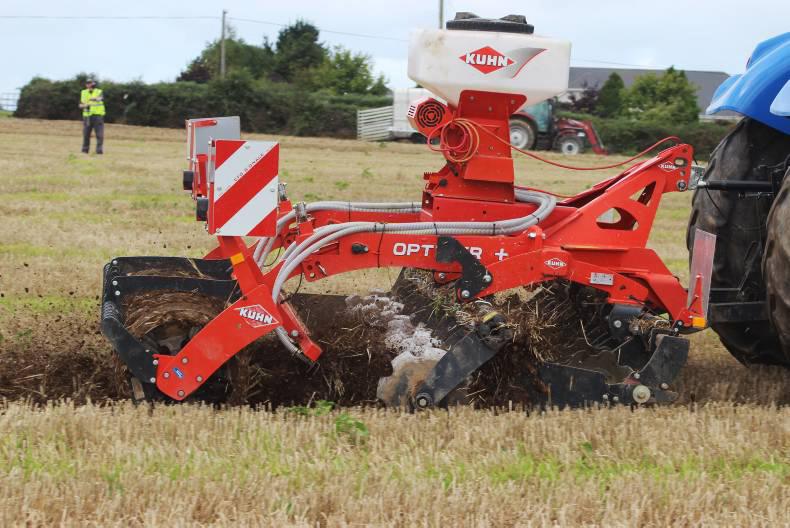
Kuhn’s Optimer + 303
This cultivator has been around for about 10 years and updated through its lifetime. The Kuhn range is handled in Ireland by Kuhn Centre Ireland Ltd.
In keeping with much of the competition, the Kuhn Optimer+ 303 features 24 scalloped discs across two rows. These are 510mm in diameter and 5mm thick. All are carried singly on their own legs and have their own individual suspension units with polyeurethane blocks.
According to Conor Donovan from Kuhn Centre Ireland, inter-body clearance between the disc and frame is greater than on older machines, providing better flow of crop residue through the machine.
Disc bearing hubs are sealed for life and bearings run in synthetic grease. Conor says that discs can be changed without any damage to the sealed bearing units.
On the rear is a T-ring packer roller. According to Conor, this is the firm’s most popular unit in Ireland. Other options include a T-liner, rubber packliner and cage/tube rollers.
Disc working depth is set by winding two manual adjusters on the Kuhn Optimer+ 303. A scale on the winder indicates the appropriate depth. The alignment of the front to rear discs can be adjusted by 100mm in total to compensate for disc wear.
For road transport, the outside discs and solid deflectors can be slid back into the machine. In the field, the unit behind the tractor is quite tidy at just 2.8 metres in length. From a fuel point of view, the tractor indicated an average of 19.6 litres/hr, which puts it in the middle ground compared with the other machines.
Andy’s view in the field
Shallow: Cut very well but was probably three inches plus. All the vegetation was undercut and the stubble was lying down. This plot looked dirty. Overall levelness of work was not great.
Deep: No issue with depth of work. This gave a lot more mixing, leaving less stubble and vegetation on top. But some of the green vegetation looked like it could regrow in damp conditions.
Double pass: This had even less vegetation showing but the finish was soft so you would need to get it planted before rain.

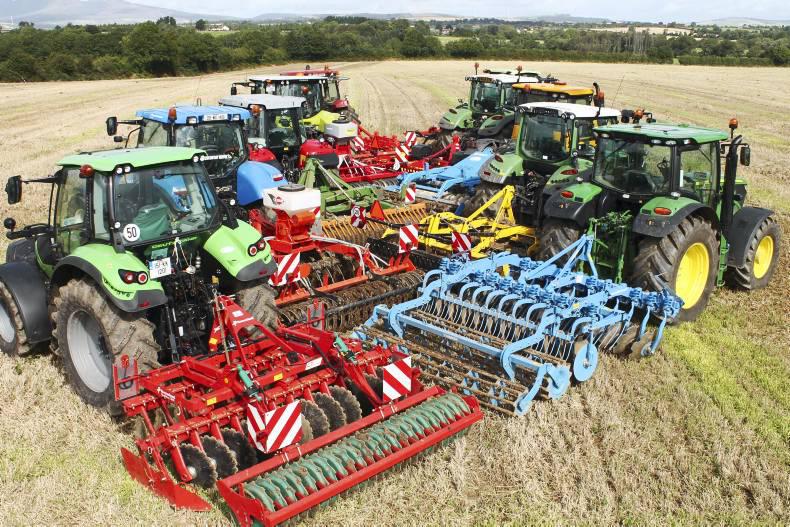




 This is a subscriber-only article
This is a subscriber-only article





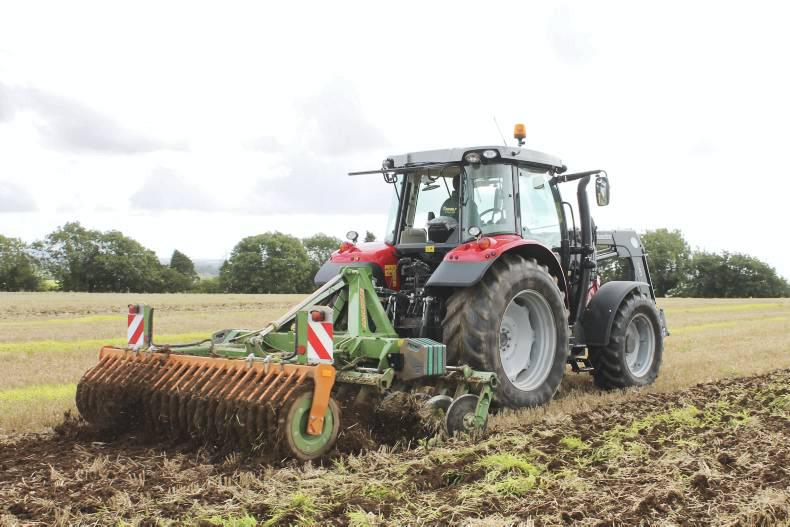

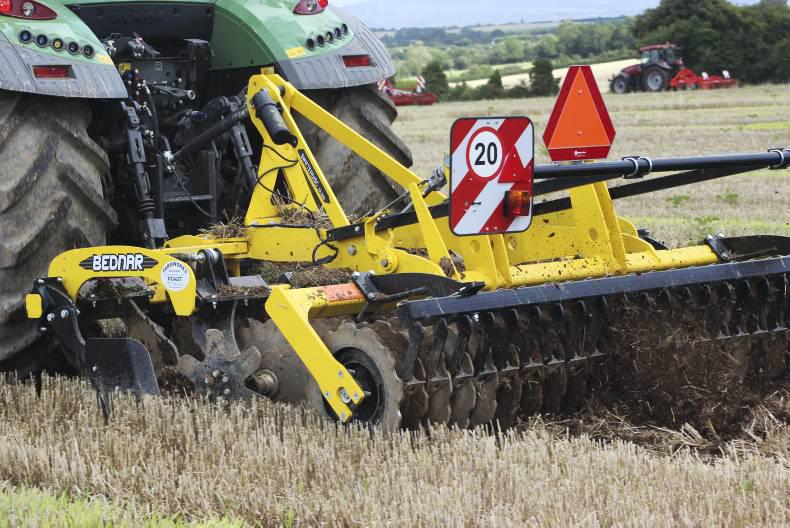



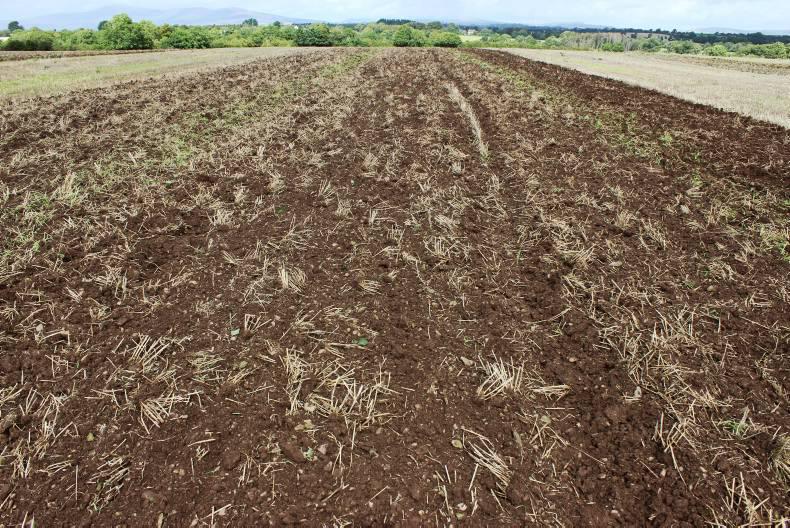




SHARING OPTIONS: